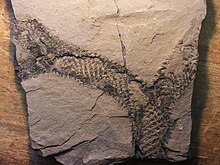Lepidodendrales
| Lepidodendrales Temporal range: Carboniferous |
|
|---|---|
 |
|
| A bifurcation in Lepidophloios | |
| Scientific classification | |
| Kingdom: | Plantae |
| Division: | Lycopodiophyta |
| Class: | Isoetopsida |
| Order: | Lepidodendrales |
| Family: | Lepidodendraceae |
| Genera | |
|
|
Lepidodendrales (from Gr. "scale tree") were primitive, vascular, arborescent (tree-like) plants related to the lycopsids (club mosses). They thrived during the Carboniferous period, and some reached heights of over 30 meters, with trunks often more than one meter in diameter. Sometimes called "giant club mosses", they are in fact more closely related to quillworts than to club mosses.
Lepidodendrales had tall, thick trunks that rarely branched and were topped with a crown of bifurcating branches bearing clusters of leaves. These leaves were long and narrow, similar to large blades of grass, and were spirally-arranged. The vascular system of the erect trunk was unusual in that it switched its morphological development as the plant grew. The young trunk began as a protostele in which the outer xylem matured first (exarch), but the later and higher portion of the trunk developed as an ectophloic siphonostele in which the xylem was flanked by phloem tissue on both its inner and outer side.
The closely packed diamond-shaped leaf scars left on the trunk and stems as the plant grew provide some of the most interesting and common fossils in Carboniferous shales and accompanying coal deposits. These fossils look much like tire tracks or alligator skin.
The scars, or leaf cushions, were composed of green photosynthetic tissue, evidenced by the cuticle covering and being dotted with stomata, microscopic pores through which carbon dioxide from the air diffuses into plants. Likewise, the trunks of Lepidodendrons would have been green, unlike modern trees which have scaly, non-photosynthetic brown or gray bark.
...
Wikipedia
